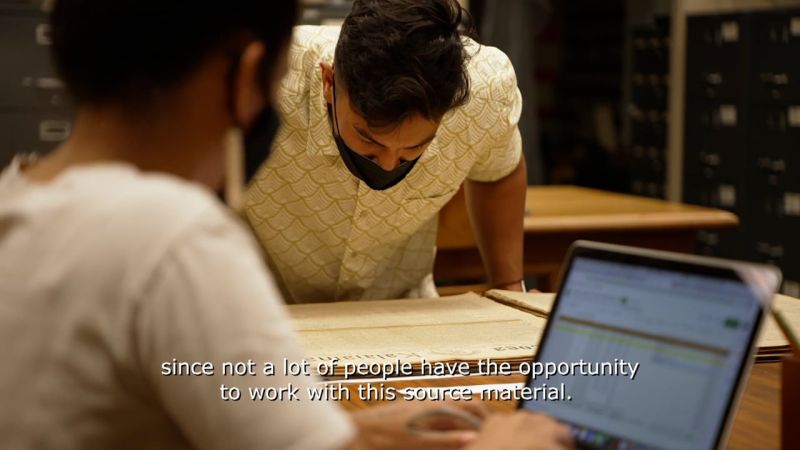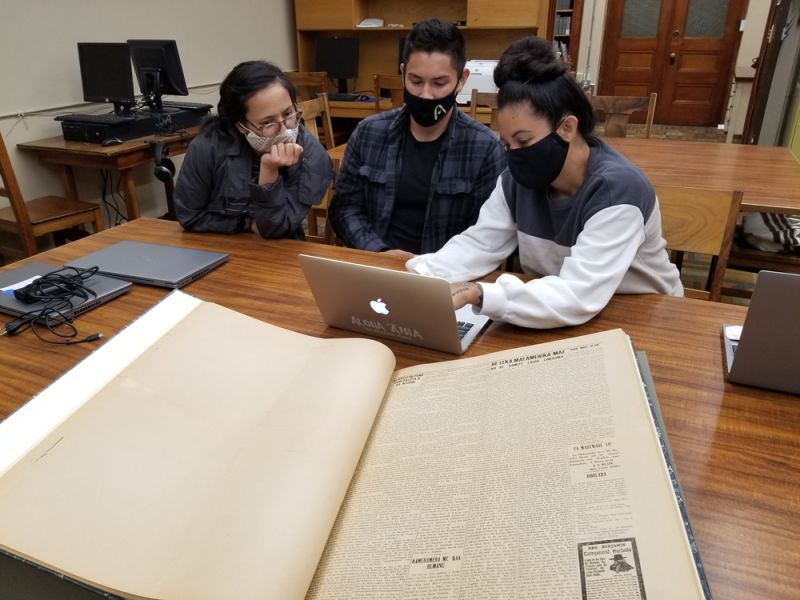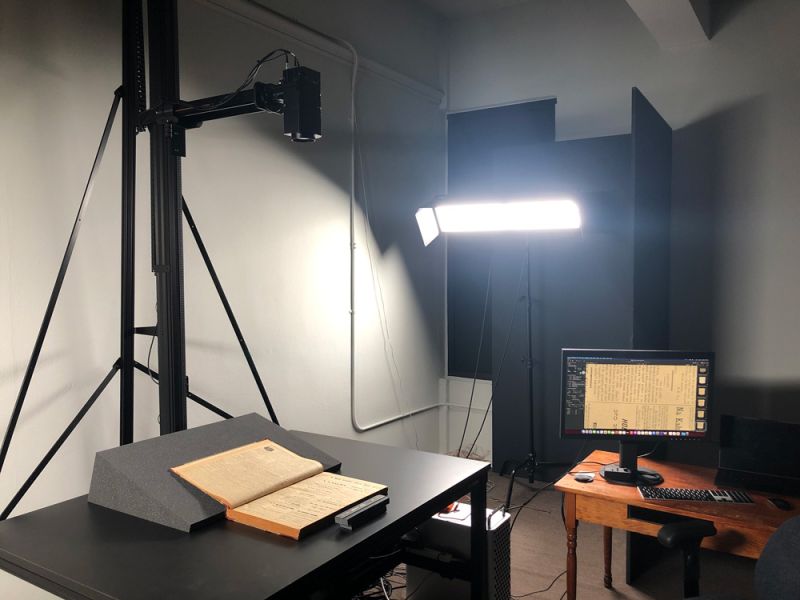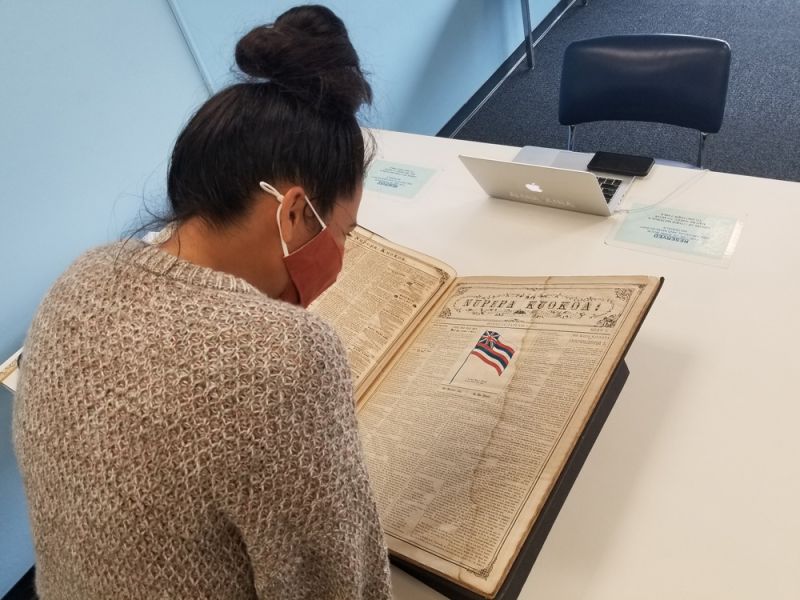Digital Collections
Celebrating the breadth and depth of Hawaiian knowledge. Amplifying Pacific voices of resiliency and hope. Recording the wisdom of past and present to help shape our future.
He Aupuni Palapala: Preserving and Digitizing the Hawaiian Language Newspapers
A collaboration between Bishop Museum and Awaiaulu Inc.,
with support from the Hawaiʻi Tourism Authority and Kamehameha Schools
“ʻAʻole oʻu makemake e paio aku; he makemake koʻu e pololei ka moʻolelo o koʻu one hānau, ʻaʻole na ka malihini e aʻo mai iaʻu i ka moʻoʻōlelo o koʻu lāhui; naʻu e aʻo aku i ka moʻolelo i ka malihini.” — S. M. Kamakau, 16 ʻOkatoba 1865, Ke Au Okoa
Ua paʻi ʻia ka nūpepa mua loa o Hawaiʻi nei, ʻo Ka Lama Hawaii, ma Lahainaluna i ka makahiki 1834, a ua hoʻomau ʻia ka paʻi ʻana i nā nūpepa Hawaiʻi (he haneli a ʻoi mau nūpepa ʻokoʻa) mai ia wā a i ka 1948. I loko o ia mau makahiki, paʻi ʻia ma kahi o 125,000 mau ʻaoʻao nūpepa, ua like ia me ka miliona me ka hapa o nā ʻaoʻao pepa leka maʻamau o kēia wā. Ma laila nō i hoʻopaʻa nui ʻia ai ka ʻike me nā moʻolelo a ka poʻe Hawaiʻi ma ka ʻōlelo kupa o ka ʻāina, a he waiwai lua ʻole ia waihona ʻike.
Eia naʻe, he mea ʻāpiki maoli ka mālama ʻana i ia mau ʻaoʻao no nā makahiki lōʻihi wale. “Hawaiian language newspapers were printed on newsprint, a medium that deteriorates rapidly, at times resulting in piles of what looks like confetti. This ʻconfetti’ previously contained crucial knowledge of Hawaiʻi, now lost to time,” wahi a Leah Caldeira, luna hoʻokele o ka Hale Waihona Puke a Palapala ʻo Pīhopa. No ia kumu, ʻaʻole ʻae nui ʻia ka nānā me ka hoʻopā ʻana aku i nā kope kumu o nā nūpepa i kēia mau lā.
ʻO nā ʻaoʻao nūpepa e ʻike ʻia nei ma Papakilo, he mau kiʻi ia o nā kiʻi aka i hana ʻia he kanalima a ʻoi makahiki i hala akula, a ʻo ka nui o ia mau kiʻi, he kū ʻole i ka nūpepa kumu. Paʻakikī ka heluhelu ʻana i kekahi mau māhele no ka maikaʻi ʻole o ke kiʻi – ʻaʻole ia no ka maikaʻi me ka ʻole o ka nūpepa kumu. A eia hou, ʻo kekahi o nā ʻaoʻao nūpepa, ʻaʻole i hoʻopaʻa ʻia ma ke ʻano he kiʻi aka, a no ia mea, ʻaʻohe ona kiʻi e hoʻouka ai ma ka pūnaewele.
No laila, me ke kākoʻo nui o ka Hawaiʻi Tourism Authority a me Ke Kula ʻo Kamehameha, ke alu like nei nā limahana o ka Hale Hōʻikeʻike ʻo Bīhopa lāua ʻo Awaiaulu no ka mālama ʻana i nā nūpepa Hawaiʻi no nā hanauna e hiki mai ana. ʻO He Aupuni Palapala: Preserving and Digitizing the Hawaiian Language Newspapers, ʻo ia ka papahana hou loa i hoʻokumu ʻia no ia hana koʻikoʻi.
“Bishop Museum stewards over half of the extant Hawaiian-language newspapers. Many, but not all, of these can be accessed online via digitized microfilmed imagery from the 1960s. While we are thankful for the security and access provided by librarians, scholars, and digital specialists through earlier preservation efforts, the current average accuracy in word searches of these newspaper images is only at 70%. He Aupuni Palapala will digitize directly from the original newspapers. This will significantly increase readability and reliability, and provide a 98% average accuracy in word searches,” wahi ā Caldeira.
ʻO ka pahu hopu o kēia papahana, ʻo ia ka paʻi ʻana i mau kiʻi hou o nā ʻaoʻao kumu a pau o nā nūpepa Hawaiʻi e mālama ʻia nei ma kekahi mau hale waihona ma ʻō ma ʻaneʻi o ka pae ʻāina.
“The project goals recall Kauikeaouli’s proclamation to his people in 1825, upon his accession to the throne, in which he stated, ‘Mine is a kingdom of literacy.’ Nūpepa were integral to his vision, providing an outlet for all Hawaiians to share information from one end of the archipelago to the other and from one generation to the next through the printed word, illustrations, and beginning in the 20th century, photography,” ʻōlelo ʻo Kauʻi Sai-Dudoit, manakia papahana no He Aupuni Palapala.
“He aupuni palapala koʻu,” penei ka ʻōlelo a ka Mōʻī Kamehameha III, a he ʻōlelo ia e kūpinaʻi mau ana a i kēia lā.
“I have no desire to argue; I want the history of my homeland to be accurate, as it is not for the foreigner to teach me the history of my people; it is for me to teach it to the foreigner.” — S. M. Kamakau, 16 October 1865, Ke Au Okoa
The very first newspaper here in Hawaiʻi, Ka Lama Hawaii, was printed at Lahainaluna in 1834, and the publication of Hawaiian newspapers continued (more than a hundred separate papers) without interruption until 1948. During that time, around 125,000 newspaper pages were published, which is comparable to approximately 1.5 million pages of today’s standard letter size paper (8.5”x11”). Within those pages, the knowledge and history of the Hawaiian people is recorded in their mother tongue, and the breadth of this repository is unequaled.
However, preserving these pages for an extended period of years is extremely challenging. “Hawaiian language newspapers were printed on newsprint, a medium that deteriorates rapidly, at times resulting in piles of what looks like confetti. This ʻconfetti’ previously contained crucial knowledge of Hawaiʻi, now lost to time,” says Leah Caldeira, director of the Library and Archives of the Bishop Museum. For that reason, permission is rarely granted to the public these days to view and handle the original copies of the newspapers.
The newspaper pages currently accessible online through the Papakilo Database are digital images taken from microfilm reels initially created over fifty years ago, and the majority of these images do not actually look like the original newspaper pages. Many sections are illegible due to the poor quality of the microfilm image, not the quality of the original newspaper itself. Furthermore, some of the newspaper pages were not even microfilmed, and because of this, there are no existing images that can be uploaded online.
Therefore, with the generous support of the Hawaiʻi Tourism Authority and Kamehameha Schools, employees of the Bishop Museum and Awaiaulu Inc. are working together to preserve the Hawaiian language newspapers for future generations. He Aupuni Palapala: Preserving and Digitizing the Hawaiian Language Newspapers is the latest project to be established for this important work.
“Bishop Museum stewards over half of the extant Hawaiian-language newspapers. Many, but not all, of these can be accessed online via digitized microfilmed imagery from the 1960s. While we are thankful for the security and access provided by librarians, scholars, and digital specialists through earlier preservation efforts, the current average accuracy in word searches of these newspaper images is only at 70%. He Aupuni Palapala will digitize directly from the original newspapers. This will significantly increase readability and reliability, and provide a 98% average accuracy in word searches,” shares Caldeira.
The goal of He Aupuni Palapala is to take brand new, high-resolution images of all original pages of the Hawaiian language newspapers housed in various repositories across Hawaiʻi.
“The project goals recall Kauikeaouli’s proclamation to his people in 1825, upon his accession to the throne, in which he stated, ‘Mine is a kingdom of literacy.’ Nūpepa were integral to his vision, providing an outlet for all Hawaiians to share information from one end of the archipelago to the other and from one generation to the next through the printed word, illustrations, and beginning in the 20th century, photography,” says Kauʻi Sai-Dudoit, project manager for He Aupuni Palapala and programs director for Awaiaulu.
“Mine is a Kingdom of education,” was the decree of King Kamehameha III, and these words continue to reverberate to this day.

video courtesy of: Hawaiʻi Tourism Authority and ʻŌiwi TV
Take a glimpse into the process behind He Aupuni Palapala, a collaboration between Bishop Museum and Awaiaulu, supported by the Hawaiʻi Tourism Authority and Kamehameha Schools.

photo courtesy of: Bishop Museum Library and Archives
Nūpepa Technicians for He Aupuni Palapala are trained to handle, assess, and inventory the Hawaiian language newspapers, many of which are bound and held in collections at the Bishop Museum Library and Archives. From left to right: ʻIolani Uliʻi, Kapaiaʻala Earle, and Kapalaiʻula de Silva.

photo courtesy of: Bishop Museum Library and Archives
Left: an example of an image digitized from microfilm and currently viewable online (article can be found in the March 16, 1867 issue of Ka Nupepa Kuokoa). Right: a new, high-quality image taken by He Aupuni Palapala nūpepa technicians of the same text, using the Bishop Museum’s copy of the original newspaper.

photo courtesy of: Bishop Museum Library and Archives
He Aupuni Palapala utilizes cutting-edge technology to take high quality digital images of original newspaper pages, thus preserving in perpetuity the voices and perspectives of our kūpuna.

photo courtesy of: Bishop Museum Library and Archives
Eventually, these new high-resolution, color photos will be uploaded to Papakilo, allowing us all to fully appreciate pages like this one – the Kuokoa issue of January 1, 1862 which features a color print of the Hawaiian flag. Color printing had only recently been developed, first appearing in London in 1855, and not appearing in the US until 1891.